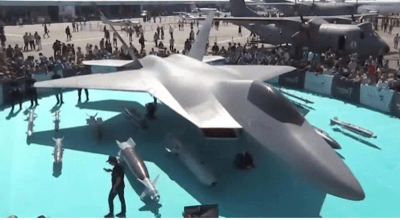Pakistan is poised to take delivery of China’s Shenyang FC-31 Gyrfalcon fifth-generation fighter jets, a potentially pivotal moment in South Asia’s bristling arms race pitting India and Pakistan with China in the middle.
This month, Defense News quoted Pakistan Air Force (PAF) chief Zaheer Baber Sidhu saying that the Chinese-made fighters, also known as F-60s or J-21 Snowy Owls, are expected to enter service shortly, without indicating an exact timeframe.
Sidhu was speaking at an induction ceremony for new military equipment that included Chinese-made K-10C Firebird fighters, the Defense News report said. The PAF chief did not indicate how many FC-31s Pakistan would acquire.
China’s FC-31/J-35 lower-cost fifth-generation fighter program seeks to compete with the US-made F-35 and fourth-generation-plus European fighters in international markets.
But unanswered questions about the FC-31’s level of stealth achievable in practice, the sensors and sensor fusion in the aircraft when operational and the time taken for delivery will all determine how effective Pakistan’s acquisition will be in counterbalancing India’s evolving capabilities, the Defense News report said.
The report also suggested that Pakistan’s JF-17, J-10 and F-16s are adequate for air superiority operations vis-à-vis India, raising questions about the need to procure FC-31s at a time Pakistan is particularly cash-strapped with the economy in a shambles.
Pakistan is a notable purchaser of Chinese fighter jets, one of a small group of countries along with Bangladesh, Myanmar, North Korea and a few African countries that have opted to procure Chinese military aircraft.
In March 2022, The Warzone reported that Pakistan had received its first Chinese-made J-10 multirole fighter jets, an acquisition that aims to enhance the PAF’s capabilities following the Indian Air Force’s (IAF) airstrike on an alleged terrorist training camp in Balakot, Pakistan, in February 2019.
The Warzone report said the PAF’s J-10 acquisition was also a response to India’s procurement of France’s Dassault Rafale multirole fighters. The J-10, equipped with advanced active-radar-guided PL-15 air-to-air missiles and active electronically scanned array (AESA) radar, will fill at least some of the strategic gap with India.
Previously, Pakistan and China co-developed the JF-17 light fighter, a strategic tie-up that could eventually lift China’s fortunes in global fighter jet markets.

In a November 2022 article for Business Insider, Benjamin Brimelow notes that the JF-17, which first flew in 2003, is in service with only Pakistan, Myanmar and Nigeria with 145 airframes as of October 2021.
Brimelow notes that the number will increase to 185 airframes by the decade’s end, making the JF-17 the most used Chinese fighter jet worldwide.
He writes that while early JF-17s were made exclusively in China, Pakistan now hosts most of the production, with 58% of the aircraft made in Pakistan and 42% in China.
Brimelow mentions that the JF-17’s US$15 to $25 million price tag makes it cheaper than any fourth-generation fighter on the market, making it an attractive option for cash-strapped air forces in the developing world that cannot afford Western aircraft.
However, Brimelow notes that the JF-17 is not designed to compete head-on with fifth-generation fighters such as the US-made F-22 and F-35 but rather is better equipped for low-intensity conflicts such as insurgencies or basic air defense against similarly equipped adversaries.
China’s fighter jet sales to Pakistan are a bright spot in its otherwise dismal performance on world markets.
Asia Times noted in January 2022 that China’s scant fighter jet sales to date owe to Beijing’s hesitance to enter cost-sharing agreements, lack of major strategic partners and the reluctance of potential partners to enter strategic tie-ups with China via fighter jet purchases.
However, China may now be consolidating Pakistan into its military logistics supply chain through sales of sophisticated weapons.
Following the US’ example, China could use Pakistan as a model for marketing its weapons on the premise that buyers join a Chinese-dominated logistics train for technical support, better pricing and access to even more advanced weapons.
Pakistan’s long-running conflict with India has made it increasingly dependent on China for relatively cheap advanced weapons, a situation that some suggest could subjugate its foreign and defense policies to Chinese interests.
As such, Pakistan is diversifying its fighter jet sources. In February 2022, Asia Times reported that Pakistan and Turkey are collaborating to develop a fifth-generation stealth fighter to replace its aging US-made F-16 fleets.
The Turkish Fighter Experimental (TF-X) project is a twin-engine multi-role aircraft with air-to-air capabilities and air-to-surface roles. In November 2022, Turkish Aerospace Industries (TAI) released video footage of the TF-X in an early stage of construction. It’s unclear how the FC-31 acquisition will impact the collaboration, if at all.

Pakistan’s China-powered air force modernization is ringing alarms in India, driving New Delhi to step up its indigenous fighter program.
In an Eurasian Times article this month, Anil Chopra says that India’s Light Combat Aircraft Mark 1A (LCA Mk1A) is on course for induction this year while the companion LCA Mk2 will make its first flight around 2025.
Meanwhile, India’s first indigenously-made fifth-generation fighter, the Advanced Medium Combat Aircraft (AMCA), is scheduled for induction around 2028-29. Chopra notes that the AMCA has two variants, the partial stealth AMCA Mk1 and stealth AMCA Mk2, with the former set to fly by 2028-29 and the latter by 2032.
Chopra suggests that India may acquire around two squadrons of F-35s as an interim measure, join the Russian Su-57 or Su-75 programs, or join Japanese or European fifth-generation programs. He asserts India’s best option is to accelerate the AMCA program and acquire around 36 F-35 units.

